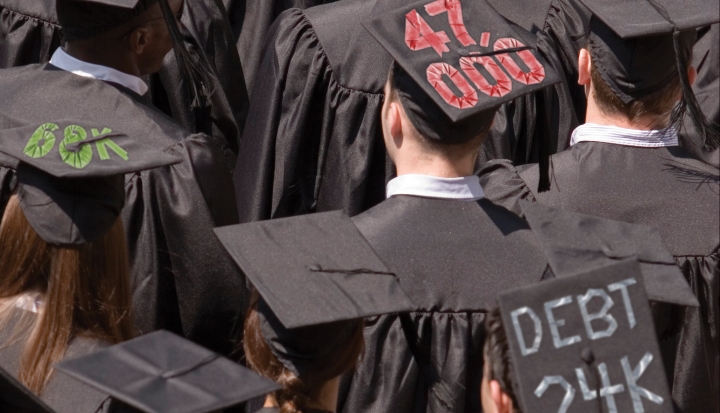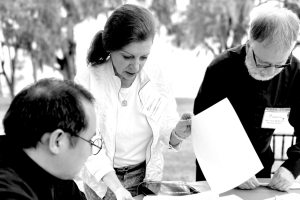The blessings of a college education often come with the curse of tens of thousands in loans. Catholic colleges are helping students get their degrees without getting buried deep in debt.
For his first three years at Duquesne University in Pittsburgh, Robert Cleveland went through the same drill every fall. He’d show up at the private Catholic university for the start of the semester, sign paperwork for his college loans, and then get busy with his coursework. At the start of his senior year, however, the aspiring music journalist began to realize how much debt he’d gotten himself into. “It just kind of creeps up on you,” he says.
By the time he graduates this spring, Cleveland will have close to $100,000 in student loan debt. His monthly payments will top $1,000. He says he’s grateful for a great education. But the price tag has left a bitter taste in his mouth. “Was it worth it?” he asks. “I don’t know.”
Students today often are paying for their education long after they’ve left campus, at a time when the nation’s economic reality has made finding a job after college difficult. About 1 in 5 American households now have student loan debt, according to a 2010 Pew Research Center report. That’s twice the number of households with debt as there were in 1989. Forty percent of households headed by people under age 35 have some type of student loan debt.
The Pew Report also lists the average student loan balance as $26,682. Although six-figure debt such as Cleveland’s may be rare, 10 percent of student debtors owe more than $61,894. Overall, student loan balances have passed the trillion-dollar mark, according to a 2013 report from the Federal Reserve Bank of New York.
While a college education is still a great investment—college graduates will have twice the average lifetime earnings of high school graduates—it comes at an increasing cost, as Cleveland and other students are learning. Especially at Catholic colleges and universities, some of which are among the country’s elite institutions, there is growing concern that low-income students will be priced out of college, or that fear of debt will prevent graduates from taking jobs such as teaching and social work that match many of the church’s values, but don’t pay well. Both colleges and students must strike a balance and find a way for quality education to not saddle students with a lifetime of debt.
Setting limits
Donna Carroll, president of Dominican University in River Forest, Illinois, says that Catholic universities and colleges are especially sensitive to the issue of debt. Many have a history of educating students from low-income or immigrant families. They are mindful about the academic and financial well-being of their students. “Catholic universities always have to ask, ‘What is our moral responsibility to our students?’ ” she says.
At Dominican, the average student debt at graduation for 2012 was about $25,000, or about $1,000 under the national average, according to Marie von Ebers, the school’s director of financial aid. That’s in part, says von Ebers, because the school has tried to hold down tuition costs in recent years.
She and her staff are also proactive in counseling students about debt, both before they arrive on campus and after they graduate. “We have a culture here that encourages a lot of one-on-one counseling,” says von Ebers. Other financial aid directors also agree that most students will have to borrow money to pay for college. But both schools and students can take steps to limit that debt. “For students at Catholic colleges, their first instinct should not be ‘borrow, borrow, borrow,’ ” von Ebers says.
At Dominican the first limits on borrowing come with the federal student loan program, known as Stafford Loans. The federal government sets limits on how much a student can borrow for school finances, especially in their early years of school. A first-year student can borrow $3,500 in subsidized Stafford Loans, where the government pays the interest while they are in school. That total goes up each year, but has a cap of $23,000 for subsidized loans. If a student wants to go beyond those limits—especially if a student wants to use a private loan from a bank or an outside lender—they must have a sit-down meeting with von Ebers’ staff.
During that meeting the staff tries to offer alternatives to borrowing privately, because those types of loans have higher limits and can get students into trouble. “When a student approaches us about using a private loan, that is when the counseling really kicks in,” von Ebers says. “We ask, ‘Do you really need to do this?’ That’s when you get them to understand the ramifications of additional borrowing.” If a student runs into a crisis, the school does have some emergency funds set aside to help him or her. The biggest donors for the funds are the Sinsinawa Dominican Sisters, who founded the college.
While the Federal Reserve Bank of New York study found that 4 in 10 students had loan balances of $10,000 or less, the report also indicated that student debt has been rapidly increasing, seeing a 70 percent rise in the average balance per student since 2004. A student with a $26,000 loan balance at 3.4 percent interest—the rate for subsidized Stafford Loans prior to July 2013—would have a monthly payment of $255.89. Those with a rate of 6.8 percent—for unsubsidized Stafford Loans—would pay $299.31 a month. Both types of loans will now have a rate of 3.86 percent, under new legislation signed by President Obama this past summer. For a student with a subsidized $26,000 loan balance, that comes out to $261.51 a month, according to finaid.org.
Paul-James Cukanna, associate provost for enrollment management at Duquesne, says it is rare for their students to run up a six-figure student loan debt. The average Duquesne student loan debt is about $26,000, he says, which matches national figures. The financial staff at the school meet with each student when they arrive on campus and go over the details of their student loans. Students can also receive additional one-on-one counseling, attend group financial aid sessions, or find online financial aid counseling.
Cukanna, too, points to the problems with private lenders, as the school can’t control what students borrow in those cases. Cukanna says Duquesne currently gives back about 45 percent of its revenue from students in the form of grants and other financial aid discounts.
Duquesne also tries to limit its costs as best it can. But hiring good faculty and offering the kind of college experience that students expect is costly, he says. And every school has limits when it comes to financial aid. “We cannot meet 100 percent of financial need,” he says. “Few institutions can do that.”
Informed consumers
Most of the students at Trinity Washington University, a Catholic college in Washington founded by the Sisters of Notre Dame de Namur in 1897, come from low-income backgrounds. Trinity president Patricia McGuire says that the school’s financial aid counselors walk students through a deliberate education process before allowing them to sign off on a loan. McGuire says that students who take on debt need to become informed consumers. “We feel strongly that when they sign the loan papers, students need to know what they are getting into,” she explains.
McGuire and other Catholic school leaders say that students and schools have to work together to keep loan balances in check. Schools have to inform students of how much money their education will cost, and students have to make hard, but realistic, choices about what school they can afford.
Oscar Sweeten-Lopez, the director of the Dell Scholars Program, which is funded by the Dell Foundation, also believes that students need to be informed consumers when it comes to choosing a school or borrowing money. The program assists about 300 low-income students a year, some of whom come from the Cristo Rey network of Catholic high schools, which encompasses 26 schools across the country that provide college preparatory education to students with limited educational opportunities. Students end up funding the majority of their education through real-world professional internships as part of a unique corporate work-study program.
Many Dell Scholars are the first in their families to go to college and are not always sure how to navigate the college financial aid system, says Sweeten-Lopez. That can lead them to make bad decisions when it comes to debt, because not all financial aid packages are equal, he says. “A college or university may say to a student, ‘We will meet 100 percent of your financial need.’ What [the students] don’t realize is that 80 percent of that aid comes from loans,” he explains. “It’s up to the students and their families to decide whether or not a college is affordable.”
The College of the Holy Cross in Worcester, Massachusetts has also taken steps to make sure that the school is affordable for low-income families in their community. About five or six years ago, the school started offering free tuition to students from Worcester who were accepted to Holy Cross if their family income was under $50,000.
In reality, many students from those families had already been receiving essentially free tuition, once all their aid was added up, explains Lynne Myers, the college’s director of financial aid. But that message was getting lost in the complicated paperwork. “Financial aid has so many details that people get lost in the data,” Myers says. “It’s much easier to say, ‘If your family income is under $50,000, you will be able to come here and receive a free education.’ ”
At Holy Cross, Myers and her staff also know that some students, especially those from poorer families, can’t afford loans, so loans aren’t part of those students’ financial aid packages. “There are some levels of income where the student doesn’t have any money to bring to the table with them,” she says. “There are some students for whom we don’t build any loans into their financial aid.”
Myers says that many schools are switching to what are known as shopping sheets—a one-page summary that lists all of a student’s aid, loans, and out-of-pocket costs. But students and their families still have to face some hard choices.
Tough decisions
After graduating in 2010 from St. Louis University, a Jesuit school, Mary Bridget Hennicke took a job with a local Catholic Charities organization. As she worked, she began considering returning to school to earn a master’s degree in social work. In addition to her own loans from undergraduate studies, her husband, whom Hennicke had met at St. Louis University, had substantial loan debt of his own. Combined, the two of them now owe more than $100,000 in loans. “We joke sometimes about meeting at a private Catholic school, and then having to combine the loans,” she says. “We joke that it’s the price of a small house between the two of us to have all these loans.”
Joking aside, Hennicke had to factor in the burden of paying for even more education. “I definitely took loans into consideration when I was thinking about going to grad school,” she says. “In general, social work doesn’t pay a lot. Sometimes I still think, ‘Wow, is this really worth it? Am I going to make enough to pay off my loans?’ But I think I did make the correct decision.”
It is easy for students to get in over their heads, as Robert Cleveland found out. He had initially planned on attending Eugene Lang College in New York City, but didn’t receive a hoped-for academic scholarship. Duquesne, he says, offered a $7,000 academic scholarship plus other aid, including loans, which made college seem feasible. It wasn’t until his senior year that the reality of the debt he’d piled up kicked in. He still hopes to work as a journalist after college, but having to pay back his student loans will make that difficult. “It’s a lot of responsibility to dive into,” he says.
Hennicke would agree. “As a college student, coming into it, I didn’t know a lot about finance in general,” she says. “I never had giant loans over my head before. I knew a lot of people took out loans and that was kind of a normal thing, but I didn’t quite realize what the amount would come to at the end.”
There are options for students who choose careers that don’t pay a high income, explains Holy Cross’ Myers. Students with federal student loans can have their payments reduced, depending on their income. “The federal loan programs have really tried to make repayment something that is manageable,” she says. “If you stay in a career that isn’t going to have a high income, your repayment plan will be set accordingly.”
Myers also says that students who enter careers such as teaching may be eligible to have parts of their loans forgiven. She hopes that fear over debt won’t keep students from pursuing those callings. “This whole argument that students won’t be able to be teachers or social workers—we don’t want to frighten off students from those fields.”
Students and their families should add up all the “free money”—including grants and scholarships—and then look at what’s left over, advises Myers. That balance has to either be covered by loans or by the student and his or her family. Myers suggests that students should only attend a school that meets a student’s full need, which may include Stafford Loans. She warns students against taking out private loans to attend a school of their dreams. That may be difficult emotionally, but it’s the right thing to do. “When a student goes to a school that doesn’t meet full [financial] need, that student is going to run into problems,” she says.
Myers also worries that increasing emphasis on the student loan debt crisis will scare some students away from going to college. She wants them to make informed decisions based on facts, not fear. “I am a little afraid that all of this hype will cause students to question going to college,” she says. “Educate people—yes. Scare people, no. Otherwise all of our hard work of telling people to aim for the sky goes for nothing.’ ”
Hennicke still believes that students should pursue what is most important to them. “I’m more of the mind that you should do what you’re passionate about,” she says. “I’m doing social work, which isn’t going to pay out very well. But I do think it’s more about what you think is going to make you happy rather than what makes you money.”
Cukanna says that Duquesne does take into account a student’s major when making financial aid decisions. Liberal arts students tend to receive more aid than students in programs like health care or pharmacy that lead to higher paying careers.
Students can follow their dreams when it comes to their studies, he says. But they also need to count the cost of doing so. That might mean attending a community college for two years, and then transferring to a school such as Duquesne. Or students might commute to a high-profile school in their community, or live off campus to cut costs.
Cukanna says that part of the school’s mission is to make college accessible to students who qualify academically. But academics are only part of the picture. He hates to turn down students who want to come to Duquesne but can’t afford to do so. “If there is a good academic fit and not a good financial fit, then a school may not be right for a student,” he says.
Worth the investment
Catholic colleges and universities, like other schools, also have to do a better job of preparing students for the workforce, says Donna Carroll of Dominican University. If students are going into debt to pay for college, they should be developing skills that will help them succeed after they graduate, she says.
Dominican has set up a “bridge to career task force” that will make a report to their long-term planning committee later on this year. Carroll says that the school is looking at ways to build career preparation into every class. “We need to help advise students thoughtfully and encourage them to have multiple options in their toolbox,” she says. This is true even for those who wish to do volunteer work, join a nonprofit, or work for the church. “We want to prepare them with as much capacity, flexibility, and goodness as we can,” she says.
Myers does see some changes coming to student loans. For one thing, she says, it’s harder to get a private loan for college. Myers says that before the recession, private loans were readily available to her students. “You could borrow on your signature if you were a Holy Cross student,” Myers says. “Now you have to have a co-borrower. No 18-year-old should be signing for a private loan.”
Colleges are also becoming more proactive about educating their graduates about the repayment process. Holy Cross has started a new program to make sure graduates know all the details of the process. That includes the name of the loan servicer and contact information for who to call if a student runs into trouble. She also says that there are options for graduates if they can’t make their payments. “If you get into trouble, pick up the phone,” she says.
Despite the worries about loan debt, Myers still tells students that a college education will pay off. “Your education is a benefit that never stops,” she says. “Your degree will never expire. Your education is going to give back to you for the rest of your life.”
Michael Galligan-Stierle, president of the Washington-based Association of Catholic Colleges and Universities, says that college completion is one area where Catholic schools excel. At public universities, only about 37 percent of students graduate in four years. That number jumps to 58 percent for Catholic schools. “Catholic college graduates get to the finish line faster than any cohort,” he says. That can lead to lower college costs and less debt.
Like many Catholic school leaders, Cukanna says that Duquesne focuses on making sure its students graduate on time. “You have to make sure that students are making academic progress,” he says. “That includes telling them that 12 credits [a semester] is not enough to graduate on time.” Cukanna also wants students to look at the long-term value of an education. “People worry about that $26,000,” he says. “But that education will shape their whole lives.”
Galligan-Stierle also says that tuition costs at many Catholic schools have gone down, relative to inflation, over the last 10 years. And their graduates have a much lower default rate on their loans. “The good news is that our default rate on student loans is about 7 percent, as compared to the overall average of 14.7 percent,” he says. The association is having its annual meeting in February, and student debt will be on the agenda. He says that Catholic colleges have to take the issue of debt seriously.
“The big picture is that the Catholic community exists to make the world a better place and to head people toward the good life,” Galligan-Stierle says. “You cannot advance the common good if someone winds up at the end of the day with a little bit of knowledge and a whole lot of debt.”
This article appeared in the February 2014 issue of U.S. Catholic (Vol. 79, No. 2, pages 12-17).
Want to read more? Here’s a web-only sidebar that discusses how student loans reduce the number of religious vocations.
Image: iStock/kickstand













Add comment